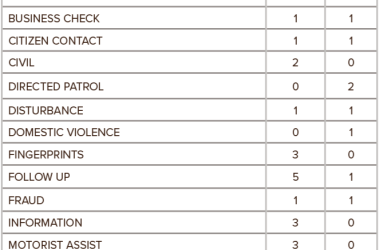RBC I The Rio Blanco County Broadband Team, under of county Information Technology Director Blake Mobley is making progress toward bringing high-speed, high-capacity broadband services to all of Rio Blanco County.
On Thursday, Mobley presented a power point outlining the progress and direction of the broadband effort. A recent Northwest Colorado Council of Governments broadband meeting held in Eagle featured the progress of Rio Blanco County’s initiative.
Rio Blanco County Commissioner Jeff Eskelson remarked that “Rio Blanco County’s approach was the centerpiece of the entire discussion as the other counties were not even close to the progress being made here, and they are studying this model for their own system designs.”
Mobley showed a comparison chart indicating the relative broadband services available in other nations throughout the world compared to the United States. Asia and Europe are far ahead of the U.S., which ranks 32nd worldwide in availability of high speed digital data transmission capability
Moreover, the rural areas of Colorado are the least well-served by broadband services due to the sparse populations and large geographic distances between population centers.
Most commercial broadband providers do not regard such sparsely populated rural areas as a good business model due to a lack of sufficient revenue derived from the large investment required to install the high-cost infrastructure necessary to deliver “last mile” broadband services to residences and businesses in communities, and particularly in sparsely populated rural areas.
With a population of about 6,000 residents, Rio Blanco County is among the smallest rural counties with the largest land mass and thus the highest cost for such infrastructure.
A creative and unique approach must be made to leverage the resources and funding necessary to be able to provide services to all residents regardless of their location. There are new technologies available that maximize the efficiency and creativity required to engineer and install such a network. The prime directive for rural broadband services requires that they be abundant, redundant, and affordable.
Rio Blanco County’s approach will be to create a collaboration of government, private enterprise, wireless [cell phone] providers, consumers and funding resources. The objective is to create a consortium of players who can bring a variety of different but essential components to the table to build a comprehensive network without having to invest large amounts of funding individually.
A request for proposal [RFP] will be distributed to various providers this week to determine what resources they may bring to the table to implement this project in a timely manner.
Federal Communications Commission grants have been applied for which are only available to sparsely populated rural areas to develop rural broadband and can dramatically improve implementation of such technology and infrastructure.
Broadband represents a renaissance in telecommunications that has not been realized since the invention of the telegraph and telephone and followed by the invention of wireless radio and television in the early 20th century.
To give some idea of what exponential leaps in capacity and speed are possible through the use of broadband, Mobley used the example of a drinking straw capable of delivering a few ounces of fluid per second representing the capacity of current broadband system access afforded by conventional telephone lines or “dial-up” service for internet.
He explained that speed and capacity are measured in “bits [of data] per second [bps].” The FCC defines broadband’s minimum threshold for download speed as 4 million bps or 4 megabits per second [mbs]. Minimum upload speeds are 1 mbs. Higher speeds are measured in trillion bits per second or gigabits [gbs].
Many urban broadband services offer 20 gbs or higher, according to application needs of the consumer.
The next step up would be a garden hose delivering about a pint of fluid per second, which by analogy is equivalent to current local Digital Subscriber Line [DSL], or by Satellite Internet Service providers now available to county residents. Only residents living in town near a local telephone central office can access DSL on their copper phone lines, which provide about 6 mbs per second download and 1 megabit per second upload. Rural residents are presently limited to satellite internet service providers with even lower download/upload rates.
The new technology providing broadband high speed digital telecommunications is generally provided by a fiber optic cable, which contains hundreds of hair-sized glass fibers, each one of which can carry the same amount of information as thousands of pairs of copper cables (currently used in conventional telephone lines), and at much higher speeds.
The comparison for a single strand of fiber optic cable is analogous to a three-foot water main delivering hundreds of gallons per second. With multiple fiber optic cables and sophisticated multiplexing systems, the speed and capacity increases to the capacity comparable to a water tunnel about 150 feet in diameter delivering millions of gallons per second. A typical multi-strand fiber optic cable is less than one inch in diameter. Continuing advances in fiber optic technology will increase speed and capacity capability to higher and higher levels still using only one strand of fiber.
Anyone who has a wired telephone and subscribes to a satellite television entertainment service, as well as to an internet service provider [ISP] in the county may be collectively spending as much as $200 to $300 per month for those services. A single fiber optic cable or wireless distributed antenna system (DAS) telecommunications service provided to an individual resident or a business can provide all of the services of telephone, internet, television and entertainment.
These services presently require separate subscriptions to several different commercial providers. However, with broadband, it may all be available in one bundled package for less than $70 per month or even less for lower capacity and speed access, where higher speeds are not required.
For rural residences and businesses, wireless DAS may provide service similar to WiFi in a home but on a much larger outdoor scale, which serves many widely separated residences indoors and outside. Fiber optic cable or microwave links deliver broadband service to a central location in the vicinity of a rural service area, which is then converted to a radio [RF] signal and transmitted through small transceiver antenna units strategically located on poles or buildings to nearby buildings with high reliability and speed.
Public Safety is a key component of the new technology.
Consumers often use cell phones or smart phones to call 911 in the event of an emergency. Wired phones are being rapidly replaced by wireless devices and more than 65 percent of all 911 calls are placed on wireless devices.
In rural mountainous areas, wireless cell towers do not provide coverage to all areas, so access to emergency communications centers may be limited or unavailable. A key element of Enhanced 911 technology is the ability to determine automatic location of the wireless device. This can be done if the phone has geosynchronous positioning satellite [GPS] location technology built in and then transmits that data to the PSAP if a 911 call is initiated. If the device does not have GPS, the sparse number of cell towers does not permit sending accurate location information to the PSAP so it may be impossible for the PSAP to determine where the call is coming from.
If a person is injured or lost in a remote wilderness area, unless they know exactly where they are, it may not be possible for dispatchers to rapidly send assistance to the precise location of the caller.
Anyone expecting to use a wireless phone for 911 calls in isolated areas should also carry a GPS receiver to provide exact location information to a dispatcher. Satellite phones work nearly anywhere, but still require a GPS to provide location data.
Broadband technology through “Next Generation 911 (NG 911)” will convert current 911 technology based on conventional wired telephone systems, to the internet “cloud,” which will accommodate smart phones and similar devices to receive voice and texted requests for emergency assistance.
Voice communications to 9-1-1 centers is always preferable to texted information to provide the most rapid and effective details for the PSAP.





















